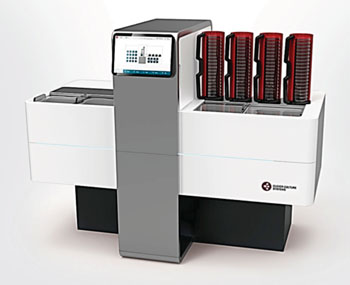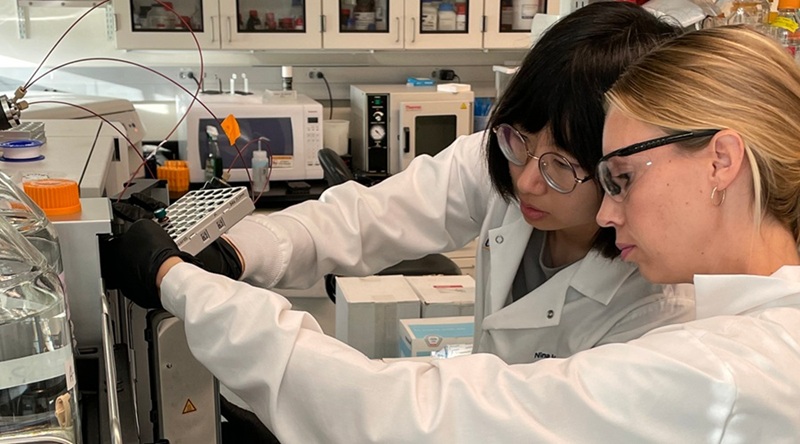Automated Imaging Speeds Up Infectious Disease Diagnosis
|
By LabMedica International staff writers Posted on 27 Oct 2016 |

Image: The Automated Plate Assessment System, or APAS, is a platform technology for the automation of culture-plate screening and interpretation (Photo courtesy of Clever Culture Systems).
Automated Plate Assessment System (APAS) is a breakthrough artificial intelligence technology for the automated imaging, image analysis, interpretation and reporting of growth on microbiology culture plates after incubation.
Thousands of agar plates are assessed in busy laboratories every day and currently each one has to be examined by a microbiologist for the presence of significant bacterial colonies. APAS automatically screens, interprets and sorts these plates, freeing up the plate reading bottleneck in laboratory workflows and microbiologists’ time and enabling faster time to patient results.
The US Food and Drug Administration (FDA, Silver Springs, MD, USA) have given 510(k) de novo submission clearance for the APAS as a class II device. The 510(k) de novo submission used a manual version of APAS to test 10,000 patients in a series of clinical trials conducted in Australia and the USA over a 12-month period. In each trial, APAS achieved its target primary endpoints and the results matched or exceeded the findings of a panel of experienced microbiologists.
The APAS was developed by LBT Innovations (Adelaide, Australia), and has been licensed on a global, exclusive basis to Clever Culture Systems AG (CCS, Bäch, Switzerland), which is integrating APAS with laboratory robotic instrumentation. CCS plans to bring APAS to market in 2017 as an automated stand-alone plate reader (APAS Independence) closely followed by the integrated incubator (APAS Incubot).
Brent Barnes, CEO of LBT Innovations, said, “FDA clearance follows rigorous interrogation and validation of the capabilities of APAS. The successful clinical trial program completed in 2015 and clearance by FDA also validate the underlying technology that is the core platform of our Company's vision to integrate imaging with interpretative intelligence to deliver faster and more secure diagnoses for patients. FDA clearance is a fitting tribute to the many years of painstaking work by LBT's staff and partners, who together have made our shared vision a reality.”
Related Links:
US Food and Drug Administration
LBT Innovations
CCS
Thousands of agar plates are assessed in busy laboratories every day and currently each one has to be examined by a microbiologist for the presence of significant bacterial colonies. APAS automatically screens, interprets and sorts these plates, freeing up the plate reading bottleneck in laboratory workflows and microbiologists’ time and enabling faster time to patient results.
The US Food and Drug Administration (FDA, Silver Springs, MD, USA) have given 510(k) de novo submission clearance for the APAS as a class II device. The 510(k) de novo submission used a manual version of APAS to test 10,000 patients in a series of clinical trials conducted in Australia and the USA over a 12-month period. In each trial, APAS achieved its target primary endpoints and the results matched or exceeded the findings of a panel of experienced microbiologists.
The APAS was developed by LBT Innovations (Adelaide, Australia), and has been licensed on a global, exclusive basis to Clever Culture Systems AG (CCS, Bäch, Switzerland), which is integrating APAS with laboratory robotic instrumentation. CCS plans to bring APAS to market in 2017 as an automated stand-alone plate reader (APAS Independence) closely followed by the integrated incubator (APAS Incubot).
Brent Barnes, CEO of LBT Innovations, said, “FDA clearance follows rigorous interrogation and validation of the capabilities of APAS. The successful clinical trial program completed in 2015 and clearance by FDA also validate the underlying technology that is the core platform of our Company's vision to integrate imaging with interpretative intelligence to deliver faster and more secure diagnoses for patients. FDA clearance is a fitting tribute to the many years of painstaking work by LBT's staff and partners, who together have made our shared vision a reality.”
Related Links:
US Food and Drug Administration
LBT Innovations
CCS
Latest Technology News
- Machine Learning Models Diagnose ALS Earlier Through Blood Biomarkers
- Artificial Intelligence Model Could Accelerate Rare Disease Diagnosis
- AI Saliva Sensor Enables Early Detection of Head and Neck Cancer
- AI-Powered Biosensor Technology to Enable Breath Test for Lung Cancer Detection
- AI Model Achieves Breakthrough Accuracy in Ovarian Cancer Detection
- Portable Biosensor Diagnoses Psychiatric Disorders Using Saliva Samples
- Cell-Sorting Device Uses Electromagnetic Levitation to Precisely Direct Cell Movement

- Embedded GPU Platform Enables Rapid Blood Profiling for POC Diagnostics
- Viral Biosensor Test Simultaneously Detects Hepatitis and HIV
- Acoustofluidic Device to Transform Point-Of-Care sEV-Based Diagnostics
- AI Algorithm Assesses Progressive Decline in Kidney Function
Channels
Clinical Chemistry
view channel
Online Tool Detects Drug Exposure Directly from Patient Samples
Doctors often rely on patient interviews and medical records to determine what medications a person has taken, but this information is frequently incomplete. People may forget drugs they used, take over-the-counter... Read more
Chemical Imaging Probe Could Track and Treat Prostate Cancer
Prostate cancer remains a leading cause of illness and death among men, with many patients eventually developing resistance to standard hormone-blocking therapies. These drugs often lose effectiveness... Read moreMolecular Diagnostics
view channel
New 15-Minute Hepatitis C Test Paves Way for Same-Day Treatment
Chronic hepatitis C infection affects an estimated 50 million people worldwide and causes around 242,000 deaths each year, largely due to cirrhosis and liver cancer. Although the infection is curable with... Read more
Ovarian Cancer Assay Outperforms Traditional Tests in Early Disease Detection
Globally, ovarian cancer is one of the deadliest cancers affecting women. Traditionally, early diagnosis of ovarian cancer has been challenging. Many ovarian cancers are diagnosed only after they have... Read moreHematology
view channel
MRD Tests Could Predict Survival in Leukemia Patients
Acute myeloid leukemia is an aggressive blood cancer that disrupts normal blood cell production and often relapses even after intensive treatment. Clinicians currently lack early, reliable markers to predict... Read more
Platelet Activity Blood Test in Middle Age Could Identify Early Alzheimer’s Risk
Early detection of Alzheimer’s disease remains one of the biggest unmet needs in neurology, particularly because the biological changes underlying the disorder begin decades before memory symptoms appear.... Read more
Microvesicles Measurement Could Detect Vascular Injury in Sickle Cell Disease Patients
Assessing disease severity in sickle cell disease (SCD) remains challenging, especially when trying to predict hemolysis, vascular injury, and risk of complications such as vaso-occlusive crises.... Read more
ADLM’s New Coagulation Testing Guidance to Improve Care for Patients on Blood Thinners
Direct oral anticoagulants (DOACs) are one of the most common types of blood thinners. Patients take them to prevent a host of complications that could arise from blood clotting, including stroke, deep... Read moreImmunology
view channel
Routine Blood Test Can Predict Who Benefits Most from CAR T-Cell Therapy
CAR T-cell therapy has transformed treatment for patients with relapsed or treatment-resistant non-Hodgkin lymphoma, but many patients eventually relapse despite an initial response. Clinicians currently... Read more
New Test Distinguishes Vaccine-Induced False Positives from Active HIV Infection
Since HIV was identified in 1983, more than 91 million people have contracted the virus, and over 44 million have died from related causes. Today, nearly 40 million individuals worldwide live with HIV-1,... Read more
Gene Signature Test Predicts Response to Key Breast Cancer Treatment
DK4/6 inhibitors paired with hormone therapy have become a cornerstone treatment for advanced HR+/HER2– breast cancer, slowing tumor growth by blocking key proteins that drive cell division.... Read more
Chip Captures Cancer Cells from Blood to Help Select Right Breast Cancer Treatment
Ductal carcinoma in situ (DCIS) accounts for about a quarter of all breast cancer cases and generally carries a good prognosis. This non-invasive form of the disease may or may not become life-threatening.... Read morePathology
view channel
Rapid Low-Cost Tests Can Prevent Child Deaths from Contaminated Medicinal Syrups
Medicinal syrups contaminated with toxic chemicals have caused the deaths of hundreds of children worldwide, exposing a critical gap in how these products are tested before reaching patients.... Read more
Tumor Signals in Saliva and Blood Enable Non-Invasive Monitoring of Head and Neck Cancer
Head and neck cancers are among the most aggressive malignancies worldwide, with nearly 900,000 new cases diagnosed each year. Monitoring these cancers for recurrence or relapse typically relies on tissue... Read more
Common Health Issues Can Influence New Blood Tests for Alzheimer’s Disease
Blood-based tests for Alzheimer’s disease are transforming diagnosis by offering a simpler alternative to spinal taps and brain imaging. However, many people evaluated at memory clinics also live with... Read more
Blood Test Formula Identifies Chronic Liver Disease Patients with Higher Cancer Risk
Chronic liver disease affects millions worldwide and can progress silently to hepatocellular carcinoma (HCC), one of the deadliest cancers globally. While surveillance guidelines exist for patients with... Read moreTechnology
view channel
Machine Learning Models Diagnose ALS Earlier Through Blood Biomarkers
Amyotrophic lateral sclerosis (ALS) is a rapidly progressive neurodegenerative disease that is notoriously difficult to diagnose in its early stages. Early symptoms often overlap with other neurological... Read more
Artificial Intelligence Model Could Accelerate Rare Disease Diagnosis
Identifying which genetic variants actually cause disease remains one of the biggest challenges in genomic medicine. Each person carries tens of thousands of DNA changes, yet only a few meaningfully alter... Read moreIndustry
view channel
Abbott Acquires Cancer-Screening Company Exact Sciences
Abbott (Abbott Park, IL, USA) has entered into a definitive agreement to acquire Exact Sciences (Madison, WI, USA), enabling it to enter and lead in fast-growing cancer diagnostics segments.... Read more



















